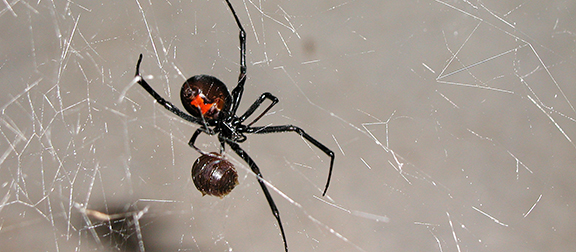Black Widow Spider Facts

DESCRIPTION:
The adult female is glossy black with a bright orange to red hourglass shaped marking on the underside of her abdomen. When mature she measures 1 1/2 inches with legs extended. The males also have the red hourglass marking but are cream and tan in color and much smaller in size. Newly hatched black widows are white with black spots on their abdomens with a cream colored hourglass. Later as they mature they become cream and brown-striped. The black widow requires about 4 months from egg to maturity with the females going through six to nine molts. Over their one to two year life span the females produce several egg sacs, each containing several hundred eggs. Female black widows guard the sac, which resembles a silken cocoon, until the eggs hatch. During this time she is most likely to bite when threatened. Eggs are most frequently encountered from May to October. All stages of both sexes are venomous. Even the egg sacs contain poison.The female black widow spins a silken web usually in protected places such as under stones, house steps, decks, etc. The webs are irregularly shaped with strands running in many directions. They are said to appear “messy”. The spiders hide during the day, and hang upside down in their webs at night.
DAMAGE:
Seldom is the spider found inside houses and black widow spiders do not aggressively hunt humans. When they bite it is to defend themselves or their eggs. The black widow venom is a nerve toxin. The initial bite may feel like a pin prick. Although bites are generally not fatal, they should be considered dangerous. Contact your local poison control center immediately. If possible, capture the spider for identification.
NOTE: Black widows are beneficial predators feeding on roaches, crickets and other pests.
MANAGEMENT:
Prevention:
- Be cautious when picking up or moving objects, particularly in outbuildings such as shed or garages, or in shady undisturbed areas such as under parked cars or in flower pots.
- Although they are not commonly found indoors it is always a good idea to shake out and check clothing before putting it on (for brown spiders and scorpions as well).
- Manage household, yard and garden insect pests (roaches, crickets etc.). Lack of food will discourage spiders and force them to move elsewhere.
- Keep out door lighting off as much as possible to prevent luring insects which the spiders feed upon.
- Remove collections of paper, boxes, rubbish piles in the house, attic, storage areas, etc.
Management:
- Destroy webs, egg sacs, and spiders by brushing or vacuuming.
- Use a fly swatter to crush.
- Only if necessary, spray spiders at night, when they are active, with a pesticide labeled for use on spiders. Follow the directions on the label explicitly.
